http://www.youtube.com/watch?v=6K_wMTpXuvQ?list=PLdI5iLA2dxuwdDrrgYWz1LE-ym1rBYqpI
Salud para todos
julio 10, 2014Informe sobre uso de drogas en población escolar
mayo 07, 2014CICAD (2010) Informe subregional sobre uso de drogas en poblacIón escolarIzada. Washington: ONUDD.
Este informe da cuenta de la magnitud del consumo de drogas y factores asociados en población de estudiantes secundarios,
cuyas edades se encuentran mayoritariamente entre los 13 y 17 años de Argentina, Bolivia, Chile, Ecuador, Perú y Uruguay.
Con respecto a la magnitud del consumo de drogas (lícitas e ilícitas), el alcohol es la droga de mayor consumo en todos los países que forman parte de este estudio. En forma general, casi siete de cada diez estudiantes ha consumido alguna vez en la vida alguna bebida alcohólica, aunque existen importantes diferencias entre los países, variando del 80% (Ecuador y Uruguay) al 43% (Bolivia).
Con respecto al tabaco, uno de cada cinco estudiantes ha consumido en el último mes. Nuevamente aquí se presenta un rango amplio entre los países. Chile presenta la prevalencia más alta (32%) y Bolivia, muestra en contrapartida la mas baja de la subregión (12%). De
todos modos, nos encontramos ante una presencia importante de consumo de alcohol y tabaco que se asocia en forma contundente con el consumo de otras drogas ilegales. En efecto, y así se consigna detalladamente en el Informe, la prevalencia de consumo de marihuana es entre 10 y 20 veces mayor entre quienes usan alcohol o tabaco respecto de quienes no consumen estas sustancias.
Con respecto a las drogas ilegales, la marihuana se presenta como la droga de mayor uso en la población estudiada. Casi el 11% de los estudiantes han experimentado alguna vez en la vida con esta sustancia variando entre un 4% en Perú hasta casi el 23% en Chile. El dato mas preocupante está relacionado con la precocidad de consumo de esta sustancia, ya que el 42% ha experimentado
por primera vez antes de los 15 años.
Con respecto a las otras sustancias ilícitas indagadas, la cocaína presenta una prevalencia de último año del 2,2%, variando entre el 1,4% (Perú) y 3,5% (Uruguay), mientras que el uso de pasta base en el último año tuvo un promedio de 1,4% con un rango de variación de 0,6% (Ecuador) hasta 2,8% (Chile). La baja percepción del riesgo de sustancias como el alcohol, tabaco y marihuana es un dato muy importante al momento de fijar las políticas públicas de reducción de la demanda. También la alta disponibilidad de acceso a la marihuana y otras drogas declarada por los estudiantes evidencia un déficit en el control del tráfico de estas sustancias que debe motivar el diseño de nuevas estrategias para el control de la oferta.
Leer el informe completo aquí
Wi Fi en las escuelas: ¿es seguro?
enero 11, 2014‘Epidemia’ de cáncer en Latinoamérica
abril 30, 2013Leer últimos datos sobre las tendencias del cáncer en América Latina aquí.
Escuchar audio(inglés) editado por the Lancet Oncology (7 minutos) aquí
Obesidad en Estados Unidos
marzo 15, 2013“Super size me” (2004. Morgan Spurlock) documental que muestra el problema de obesidad influido por la comida rápida.
Ver aquí
La salud en Estados Unidos (Sicko)
marzo 15, 2013Sicko (2007) es el documental de Michael Moore que presenta un enfoque crítico del sistema de salud de Estados Unidos, el cual es comparado con el sistema de otros países.
Ver documental aquí
Smoke adults in USA / Consumo de tabaco adultos en Estados Unidos
febrero 15, 2013US Adult Smoking Statistics Tabaquismo en adultos de Estados Unidos (mayores de 25 años)
SOURCE: National Health Interview Survey, 2010
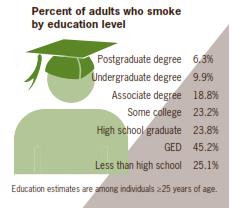
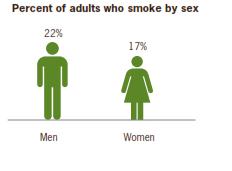
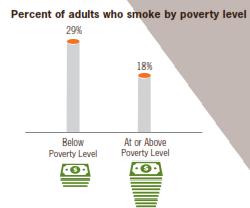
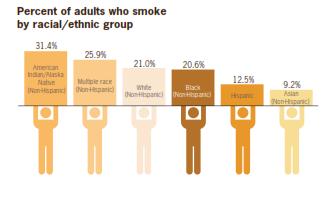
Figuras tomadas de CDC Vital Signs,sept. 2011
Ver informe aquí
Sigue leyendo
¿Y si nuestro sistema de salud nos mantuviera sanos?
octubre 07, 2012El peso de una nación (obesidad en Estados Unidos)
junio 18, 2012“The weight of the nation” (2012) es un documental producido por HBO y el Institute of Medicine (IOM) de los Estados Unidos, que aborda en varios capítulos la epidemia de la obesidad en dicho país.
Ver los 4 capítulos de este documental son subtitulos en español aquí (a la mano derecha buscar “settings” y hacer click donde dice “spanish” ) Sigue leyendo
Aumento de cáncer al pulmón en mujeres mayores
abril 15, 2012Tendencias de cáncer al pulmón en mujeres en EEUU y Reino Unido
Lung cancer incidence rate has strongly increased among women aged 65 and older.
Although lung cancer can occur at any age, it is most commonly diagnosed in persons aged 65 or older. In the US, the lung cancer incidence rates over the past three decades have increased about 3.5 times in elderly women over age 65. Over the same time period, the incidence rates in women under 65 have remained almost unchanged.
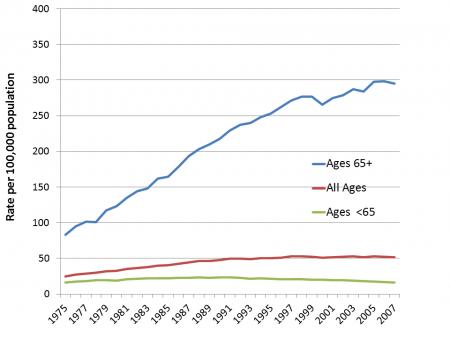
Lung Cancer Rates in Women (EEUU)
The peak in female smokers came later than the peak in male smokers. Correspondingly, lung cancer rates peaked earlier for men than for women. So while lung cancer rates among men declined through the 1990s, women’s rates continued to rise slowly. In the last decade, women’s rates finally leveled off and began turning downward. The rate of new lung cancer diagnoses among women is now steadily decreasing by less than 1 percent each year.

Fuente:http://www.asbestos.com/cancer/lung-cancer/women.php
Lung cancer cases keep going up in women
Friday 13 April 2012
Cancer Research UK Press Release
Lung cancer cases continue to rise in women with more than 18,000 UK women diagnosed with the disease in 2009 according to the latest Cancer Research UK figures released today (Friday).
Rates of the disease have risen to 39.3 for every 100,000 UK women from 22.2 for every 100,000 in 1975 when there were fewer than 8,000 cases.
Lung cancer is still more common in men with more than 23,000 cases in 2009 but rates in men have been falling fast. Male lung cancer incidence is now 58.8 per 100,000 UK men compared with 110 in 1975.
Cases of lung cancer mirror smoking rates around two to three decades earlier as more than 80 per cent of cases are caused by tobacco. And the differences in lung cancer cases for men and women reflect the smoking patterns in previous decades for each sex.
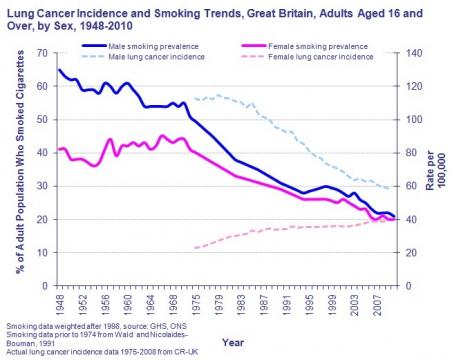
Smoking rates for women in Great Britain were highest throughout the “Mad Men” era of the 1960s, with around 45 per cent of women smoking. This has since fallen to 20 per cent.
More than 65 per cent of men smoked during World War II and throughout the rest of the 1940s with lung cancer rates in men peaking around 30 years later in 1979 at nearly 115 men out of every 100,000. Now, 22 per cent of men are smokers.
The new figures also reveal that the total number of UK lung cancer deaths stands at almost 35,000. 19,410 men and 15,449 women died from the disease in 2010.
Until the late 1990s, lung cancer was the most common cancer in the UK. In 1997 it was overtaken by breast cancer, but still accounts for 14 per cent of all new cancer cases in men, and 11 per cent in women.
Several publications have been important in highlighting the dangers of smoking, helping reduce the number of smokers and ultimately lung cancer incidence.
The British Doctors’ Study – partly funded by Cancer Research UK – ran from 1951 to 2001 and was the first to show that smoking increases the risk of lung cancer. It went on to clearly show the benefits of quitting. The 1962 Royal College of Physicians’ report, Smoking and Health, helped change the perception of smoking and raised awareness of smoking-related diseases. This report also set out key recommendation on how to reduce smoking rates – such as removing tobacco advertising from TV.
Successful anti-smoking measures – such as the tobacco advertising ban and the legislation making public places smokefree – have also meant the number of smokers has continued to drop. Large shops and supermarkets have recently removed tobacco from sight, with smaller retailers doing the same in 2015.
The next step is to reduce one of the remaining means of tobacco marketing to children. The government is due to consult on removing all branding from tobacco packaging. This would mean the glitzy, brightly-coloured packs would become a uniform colour, size and shape. Further measures at EU level could introduce large picture warnings on the front and back of the pack.
Jean King, Cancer Research UK’s director of tobacco control, said: “These latest figures highlight the deadly impact of tobacco. The continuing rise of lung cancer in women reflects the high number of female smokers several decades ago when attitudes were different. Tobacco advertising hasn’t appeared on UK television since 1965, but that didn’t stop the marketing of cigarettes. New, more sophisticated marketing techniques have lured many hundreds of thousands into starting an addiction that will kill half of all long term smokers.
“It’s vital that the UK closes one of the last remaining loopholes that portrays smoking as something glamorous and normal, rather than the lethal product it truly is. Ending the packet racket and putting all cigarettes in plain packs with large health warnings is crucial. No one wants to see children take up smoking, and while plain packs won’t stop everyone from smoking, it will give millions of children one less reason to start.”
Sara Hiom, Cancer Research UK’s information director, said: “Lung cancer continues to claim far too many lives. More than four in five cases of the disease are caused directly by smoking. But this means nearly one in five cases is not. It’s really important that anyone with a cough that lasts for three weeks or a worsening or a change in a long-standing cough get this checked out.
“Also, it’s never too late to give up smoking – you will reduce your risk of developing lung cancer and other serious diseases. Your GP or local pharmacy can advise you where to find your local NHS support services.”
fuente:http://info.cancerresearchuk.org/news/archive/pressrelease/2012-04-13-Lung-cancer-cases-keep-going-up-in-women?view=rss Sigue leyendo
